University Design Thinking Course: Weekly Blogs Reflection Report
VerifiedAdded on 2020/03/16
|12
|2251
|47
Report
AI Summary
This report presents a student's reflective analysis of a 12-week design thinking course, detailing their learning experiences across various modules. The report begins with an introduction to design thinking and its importance, followed by a discussion of weekly blog content covering Design IT, the design process, theory, and problem-solving. The student reflects on topics such as design research, prototyping, entrepreneurial marketing, and future-oriented design. The conclusion emphasizes the significance of design thinking for problem-solving. The report also includes a bibliography of relevant sources and an action plan for creating vlogs based on the course content. The student reflects on the application of design thinking in real-life situations, the course's impact on their understanding, and the tools and methods learned throughout the course. The report offers a comprehensive overview of the student's engagement with the course material.
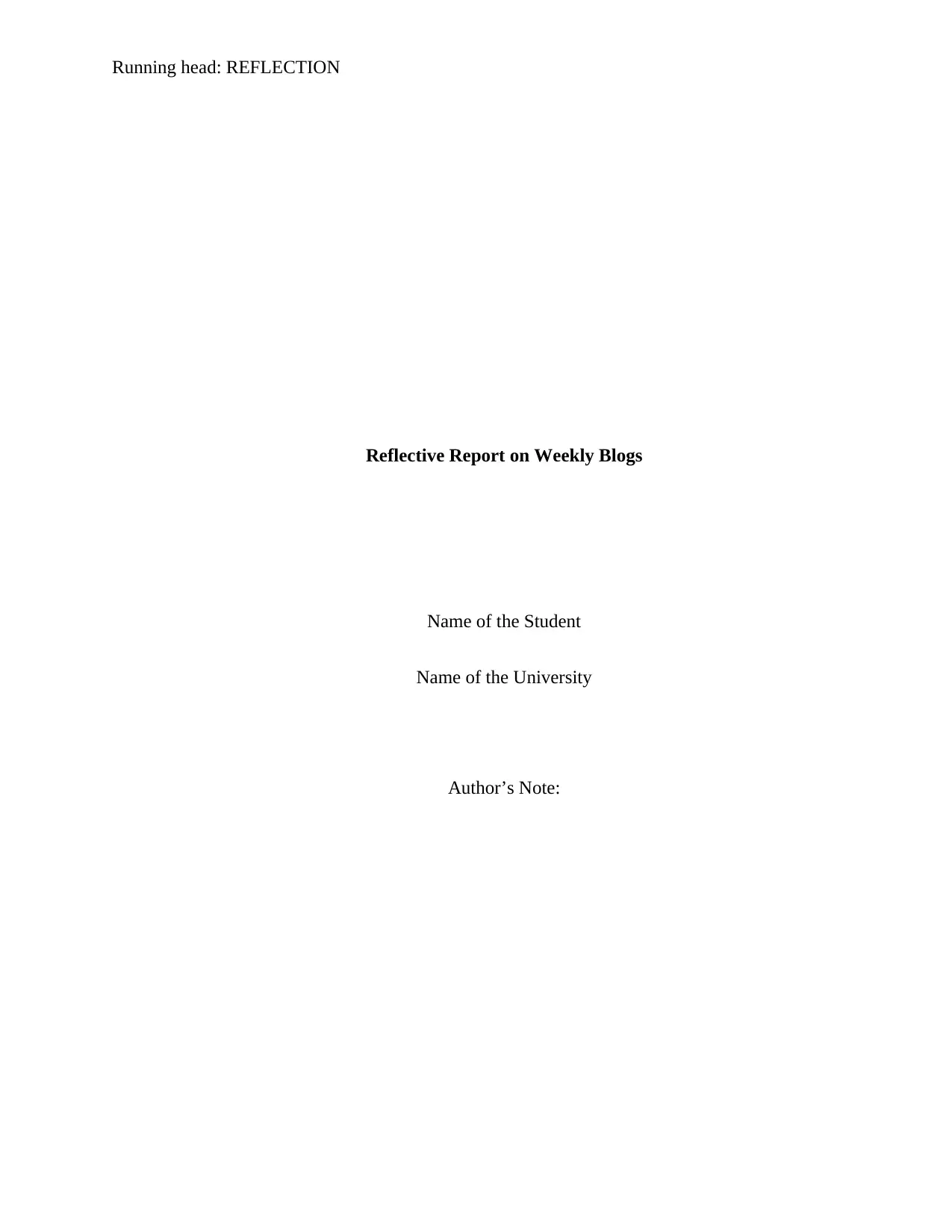
Running head: REFLECTION
Reflective Report on Weekly Blogs
Name of the Student
Name of the University
Author’s Note:
Reflective Report on Weekly Blogs
Name of the Student
Name of the University
Author’s Note:
Paraphrase This Document
Need a fresh take? Get an instant paraphrase of this document with our AI Paraphraser
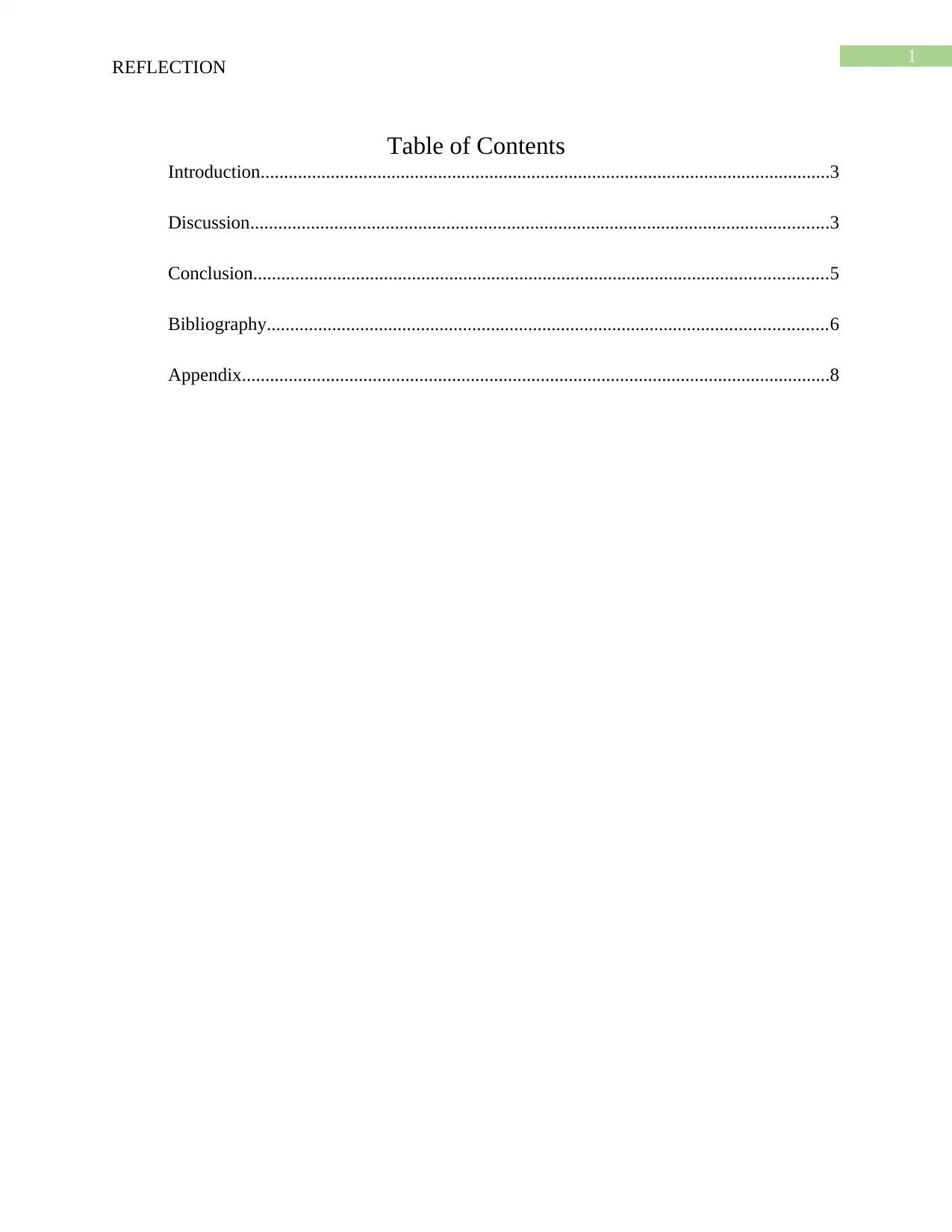
1
REFLECTION
Table of Contents
Introduction..........................................................................................................................3
Discussion............................................................................................................................3
Conclusion...........................................................................................................................5
Bibliography........................................................................................................................6
Appendix..............................................................................................................................8
REFLECTION
Table of Contents
Introduction..........................................................................................................................3
Discussion............................................................................................................................3
Conclusion...........................................................................................................................5
Bibliography........................................................................................................................6
Appendix..............................................................................................................................8
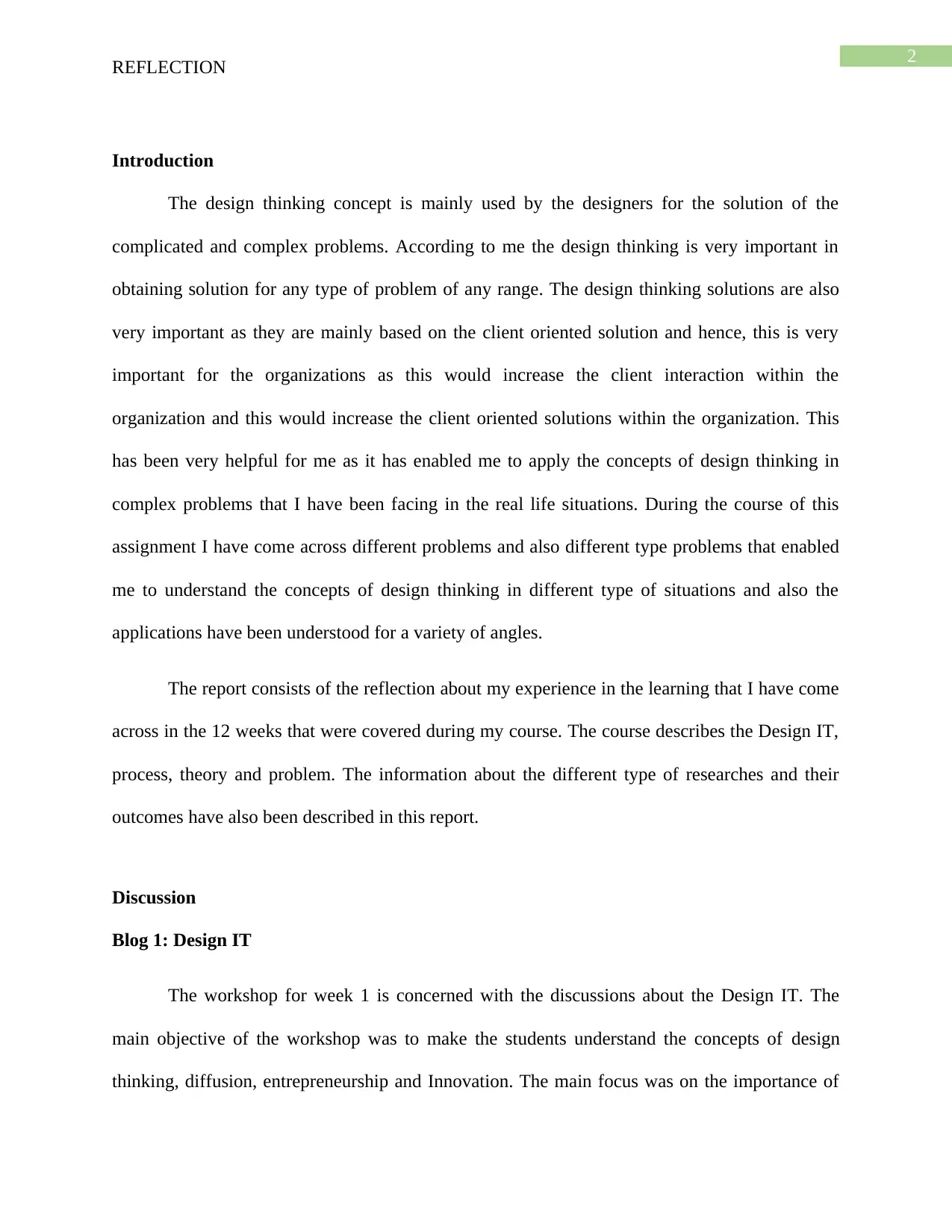
2
REFLECTION
Introduction
The design thinking concept is mainly used by the designers for the solution of the
complicated and complex problems. According to me the design thinking is very important in
obtaining solution for any type of problem of any range. The design thinking solutions are also
very important as they are mainly based on the client oriented solution and hence, this is very
important for the organizations as this would increase the client interaction within the
organization and this would increase the client oriented solutions within the organization. This
has been very helpful for me as it has enabled me to apply the concepts of design thinking in
complex problems that I have been facing in the real life situations. During the course of this
assignment I have come across different problems and also different type problems that enabled
me to understand the concepts of design thinking in different type of situations and also the
applications have been understood for a variety of angles.
The report consists of the reflection about my experience in the learning that I have come
across in the 12 weeks that were covered during my course. The course describes the Design IT,
process, theory and problem. The information about the different type of researches and their
outcomes have also been described in this report.
Discussion
Blog 1: Design IT
The workshop for week 1 is concerned with the discussions about the Design IT. The
main objective of the workshop was to make the students understand the concepts of design
thinking, diffusion, entrepreneurship and Innovation. The main focus was on the importance of
REFLECTION
Introduction
The design thinking concept is mainly used by the designers for the solution of the
complicated and complex problems. According to me the design thinking is very important in
obtaining solution for any type of problem of any range. The design thinking solutions are also
very important as they are mainly based on the client oriented solution and hence, this is very
important for the organizations as this would increase the client interaction within the
organization and this would increase the client oriented solutions within the organization. This
has been very helpful for me as it has enabled me to apply the concepts of design thinking in
complex problems that I have been facing in the real life situations. During the course of this
assignment I have come across different problems and also different type problems that enabled
me to understand the concepts of design thinking in different type of situations and also the
applications have been understood for a variety of angles.
The report consists of the reflection about my experience in the learning that I have come
across in the 12 weeks that were covered during my course. The course describes the Design IT,
process, theory and problem. The information about the different type of researches and their
outcomes have also been described in this report.
Discussion
Blog 1: Design IT
The workshop for week 1 is concerned with the discussions about the Design IT. The
main objective of the workshop was to make the students understand the concepts of design
thinking, diffusion, entrepreneurship and Innovation. The main focus was on the importance of
⊘ This is a preview!⊘
Do you want full access?
Subscribe today to unlock all pages.

Trusted by 1+ million students worldwide
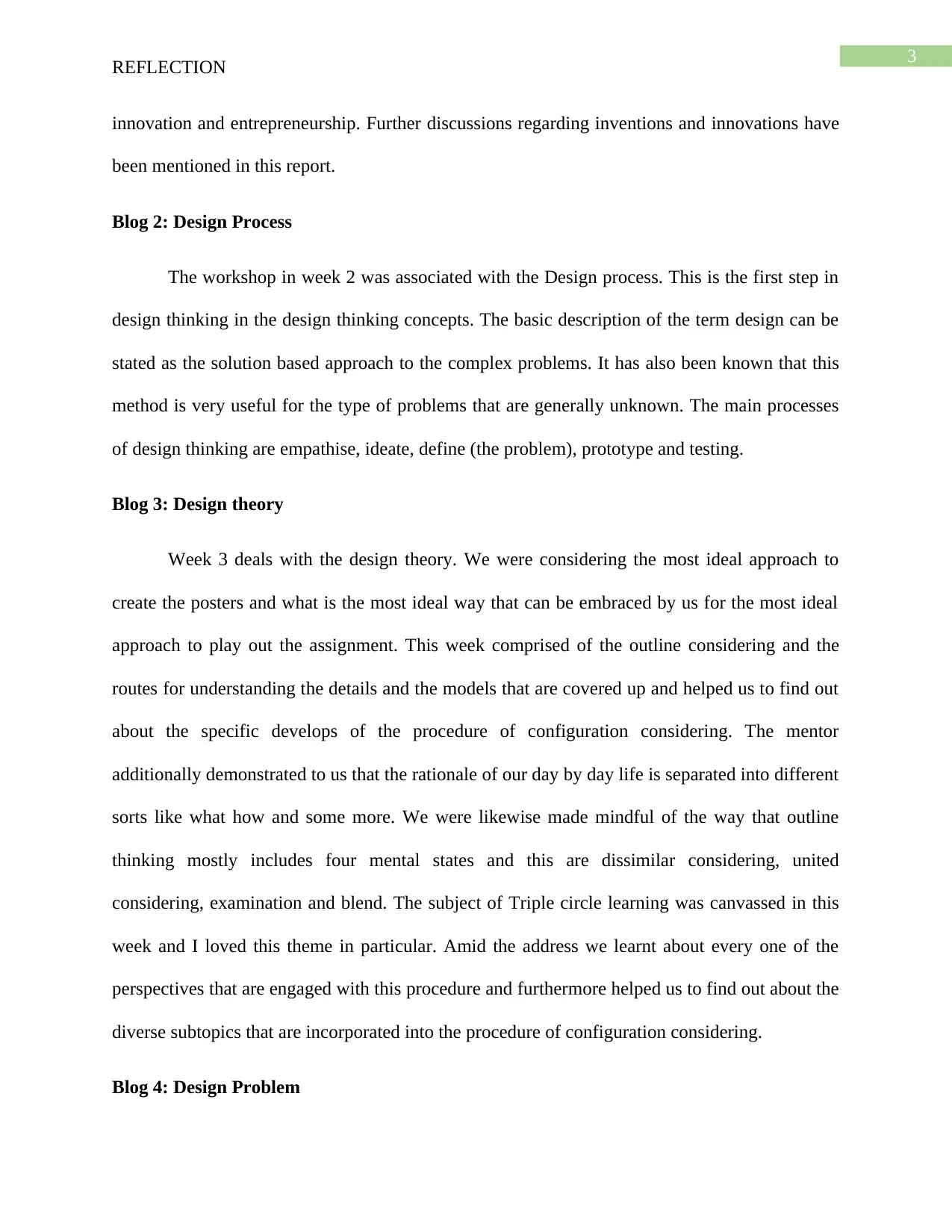
3
REFLECTION
innovation and entrepreneurship. Further discussions regarding inventions and innovations have
been mentioned in this report.
Blog 2: Design Process
The workshop in week 2 was associated with the Design process. This is the first step in
design thinking in the design thinking concepts. The basic description of the term design can be
stated as the solution based approach to the complex problems. It has also been known that this
method is very useful for the type of problems that are generally unknown. The main processes
of design thinking are empathise, ideate, define (the problem), prototype and testing.
Blog 3: Design theory
Week 3 deals with the design theory. We were considering the most ideal approach to
create the posters and what is the most ideal way that can be embraced by us for the most ideal
approach to play out the assignment. This week comprised of the outline considering and the
routes for understanding the details and the models that are covered up and helped us to find out
about the specific develops of the procedure of configuration considering. The mentor
additionally demonstrated to us that the rationale of our day by day life is separated into different
sorts like what how and some more. We were likewise made mindful of the way that outline
thinking mostly includes four mental states and this are dissimilar considering, united
considering, examination and blend. The subject of Triple circle learning was canvassed in this
week and I loved this theme in particular. Amid the address we learnt about every one of the
perspectives that are engaged with this procedure and furthermore helped us to find out about the
diverse subtopics that are incorporated into the procedure of configuration considering.
Blog 4: Design Problem
REFLECTION
innovation and entrepreneurship. Further discussions regarding inventions and innovations have
been mentioned in this report.
Blog 2: Design Process
The workshop in week 2 was associated with the Design process. This is the first step in
design thinking in the design thinking concepts. The basic description of the term design can be
stated as the solution based approach to the complex problems. It has also been known that this
method is very useful for the type of problems that are generally unknown. The main processes
of design thinking are empathise, ideate, define (the problem), prototype and testing.
Blog 3: Design theory
Week 3 deals with the design theory. We were considering the most ideal approach to
create the posters and what is the most ideal way that can be embraced by us for the most ideal
approach to play out the assignment. This week comprised of the outline considering and the
routes for understanding the details and the models that are covered up and helped us to find out
about the specific develops of the procedure of configuration considering. The mentor
additionally demonstrated to us that the rationale of our day by day life is separated into different
sorts like what how and some more. We were likewise made mindful of the way that outline
thinking mostly includes four mental states and this are dissimilar considering, united
considering, examination and blend. The subject of Triple circle learning was canvassed in this
week and I loved this theme in particular. Amid the address we learnt about every one of the
perspectives that are engaged with this procedure and furthermore helped us to find out about the
diverse subtopics that are incorporated into the procedure of configuration considering.
Blog 4: Design Problem
Paraphrase This Document
Need a fresh take? Get an instant paraphrase of this document with our AI Paraphraser
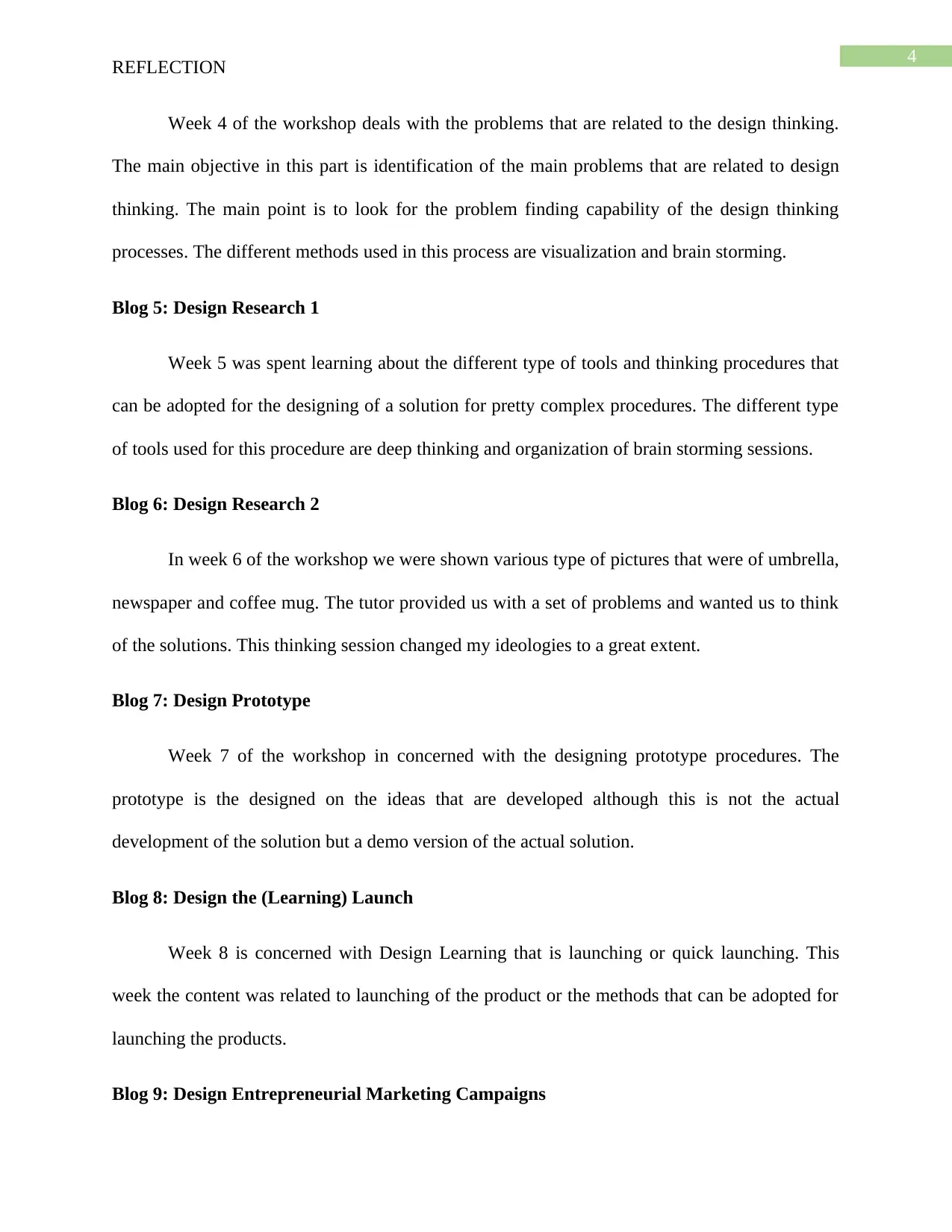
4
REFLECTION
Week 4 of the workshop deals with the problems that are related to the design thinking.
The main objective in this part is identification of the main problems that are related to design
thinking. The main point is to look for the problem finding capability of the design thinking
processes. The different methods used in this process are visualization and brain storming.
Blog 5: Design Research 1
Week 5 was spent learning about the different type of tools and thinking procedures that
can be adopted for the designing of a solution for pretty complex procedures. The different type
of tools used for this procedure are deep thinking and organization of brain storming sessions.
Blog 6: Design Research 2
In week 6 of the workshop we were shown various type of pictures that were of umbrella,
newspaper and coffee mug. The tutor provided us with a set of problems and wanted us to think
of the solutions. This thinking session changed my ideologies to a great extent.
Blog 7: Design Prototype
Week 7 of the workshop in concerned with the designing prototype procedures. The
prototype is the designed on the ideas that are developed although this is not the actual
development of the solution but a demo version of the actual solution.
Blog 8: Design the (Learning) Launch
Week 8 is concerned with Design Learning that is launching or quick launching. This
week the content was related to launching of the product or the methods that can be adopted for
launching the products.
Blog 9: Design Entrepreneurial Marketing Campaigns
REFLECTION
Week 4 of the workshop deals with the problems that are related to the design thinking.
The main objective in this part is identification of the main problems that are related to design
thinking. The main point is to look for the problem finding capability of the design thinking
processes. The different methods used in this process are visualization and brain storming.
Blog 5: Design Research 1
Week 5 was spent learning about the different type of tools and thinking procedures that
can be adopted for the designing of a solution for pretty complex procedures. The different type
of tools used for this procedure are deep thinking and organization of brain storming sessions.
Blog 6: Design Research 2
In week 6 of the workshop we were shown various type of pictures that were of umbrella,
newspaper and coffee mug. The tutor provided us with a set of problems and wanted us to think
of the solutions. This thinking session changed my ideologies to a great extent.
Blog 7: Design Prototype
Week 7 of the workshop in concerned with the designing prototype procedures. The
prototype is the designed on the ideas that are developed although this is not the actual
development of the solution but a demo version of the actual solution.
Blog 8: Design the (Learning) Launch
Week 8 is concerned with Design Learning that is launching or quick launching. This
week the content was related to launching of the product or the methods that can be adopted for
launching the products.
Blog 9: Design Entrepreneurial Marketing Campaigns
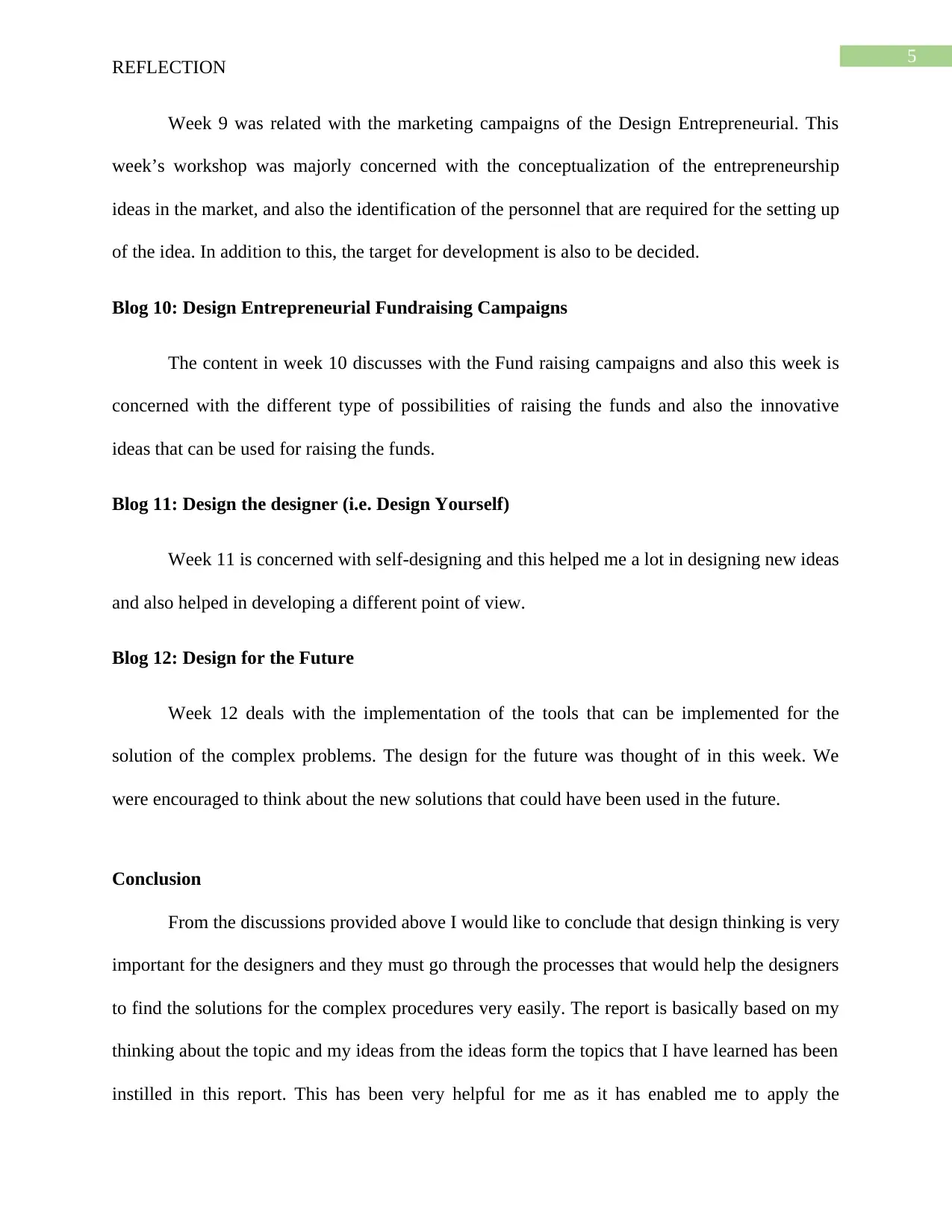
5
REFLECTION
Week 9 was related with the marketing campaigns of the Design Entrepreneurial. This
week’s workshop was majorly concerned with the conceptualization of the entrepreneurship
ideas in the market, and also the identification of the personnel that are required for the setting up
of the idea. In addition to this, the target for development is also to be decided.
Blog 10: Design Entrepreneurial Fundraising Campaigns
The content in week 10 discusses with the Fund raising campaigns and also this week is
concerned with the different type of possibilities of raising the funds and also the innovative
ideas that can be used for raising the funds.
Blog 11: Design the designer (i.e. Design Yourself)
Week 11 is concerned with self-designing and this helped me a lot in designing new ideas
and also helped in developing a different point of view.
Blog 12: Design for the Future
Week 12 deals with the implementation of the tools that can be implemented for the
solution of the complex problems. The design for the future was thought of in this week. We
were encouraged to think about the new solutions that could have been used in the future.
Conclusion
From the discussions provided above I would like to conclude that design thinking is very
important for the designers and they must go through the processes that would help the designers
to find the solutions for the complex procedures very easily. The report is basically based on my
thinking about the topic and my ideas from the ideas form the topics that I have learned has been
instilled in this report. This has been very helpful for me as it has enabled me to apply the
REFLECTION
Week 9 was related with the marketing campaigns of the Design Entrepreneurial. This
week’s workshop was majorly concerned with the conceptualization of the entrepreneurship
ideas in the market, and also the identification of the personnel that are required for the setting up
of the idea. In addition to this, the target for development is also to be decided.
Blog 10: Design Entrepreneurial Fundraising Campaigns
The content in week 10 discusses with the Fund raising campaigns and also this week is
concerned with the different type of possibilities of raising the funds and also the innovative
ideas that can be used for raising the funds.
Blog 11: Design the designer (i.e. Design Yourself)
Week 11 is concerned with self-designing and this helped me a lot in designing new ideas
and also helped in developing a different point of view.
Blog 12: Design for the Future
Week 12 deals with the implementation of the tools that can be implemented for the
solution of the complex problems. The design for the future was thought of in this week. We
were encouraged to think about the new solutions that could have been used in the future.
Conclusion
From the discussions provided above I would like to conclude that design thinking is very
important for the designers and they must go through the processes that would help the designers
to find the solutions for the complex procedures very easily. The report is basically based on my
thinking about the topic and my ideas from the ideas form the topics that I have learned has been
instilled in this report. This has been very helpful for me as it has enabled me to apply the
⊘ This is a preview!⊘
Do you want full access?
Subscribe today to unlock all pages.

Trusted by 1+ million students worldwide
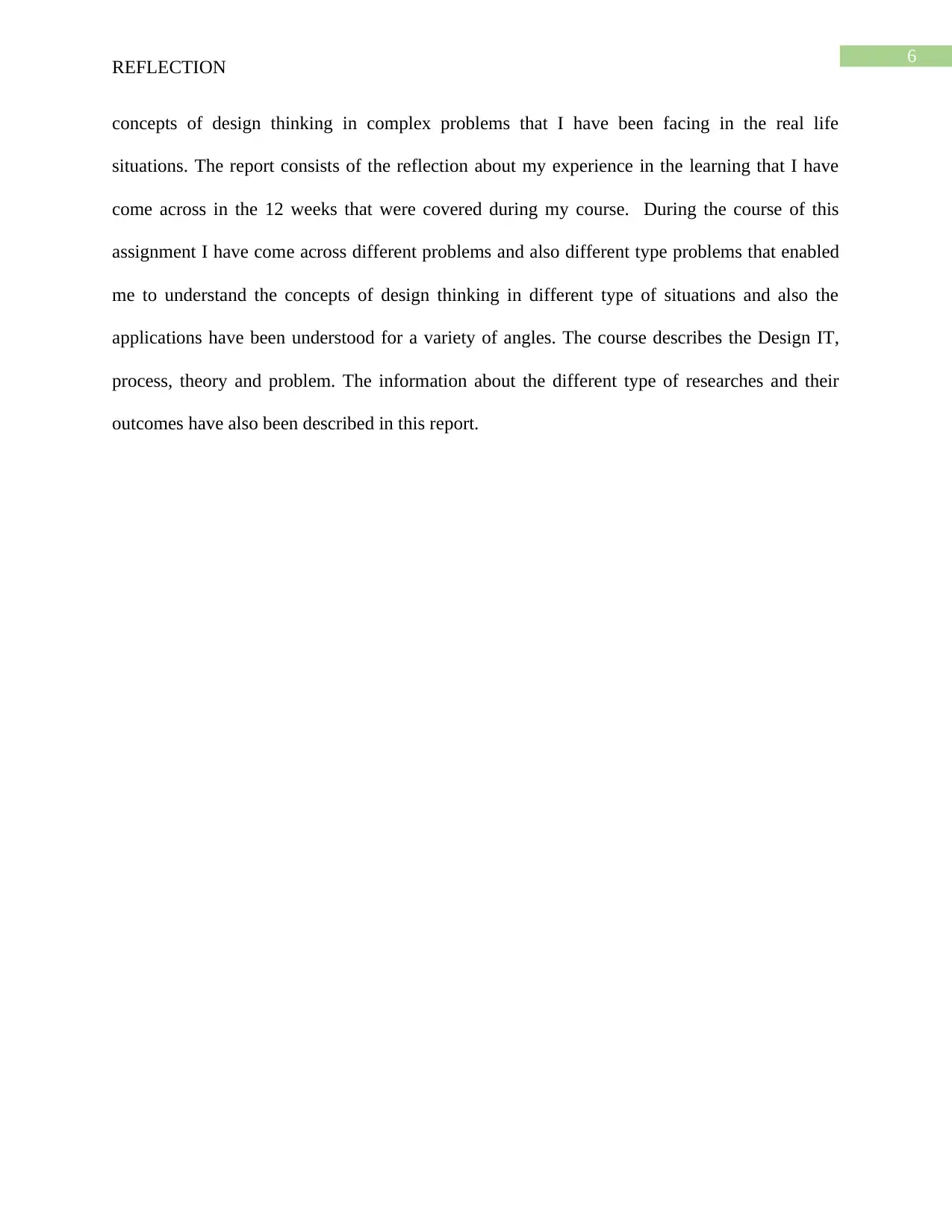
6
REFLECTION
concepts of design thinking in complex problems that I have been facing in the real life
situations. The report consists of the reflection about my experience in the learning that I have
come across in the 12 weeks that were covered during my course. During the course of this
assignment I have come across different problems and also different type problems that enabled
me to understand the concepts of design thinking in different type of situations and also the
applications have been understood for a variety of angles. The course describes the Design IT,
process, theory and problem. The information about the different type of researches and their
outcomes have also been described in this report.
REFLECTION
concepts of design thinking in complex problems that I have been facing in the real life
situations. The report consists of the reflection about my experience in the learning that I have
come across in the 12 weeks that were covered during my course. During the course of this
assignment I have come across different problems and also different type problems that enabled
me to understand the concepts of design thinking in different type of situations and also the
applications have been understood for a variety of angles. The course describes the Design IT,
process, theory and problem. The information about the different type of researches and their
outcomes have also been described in this report.
Paraphrase This Document
Need a fresh take? Get an instant paraphrase of this document with our AI Paraphraser
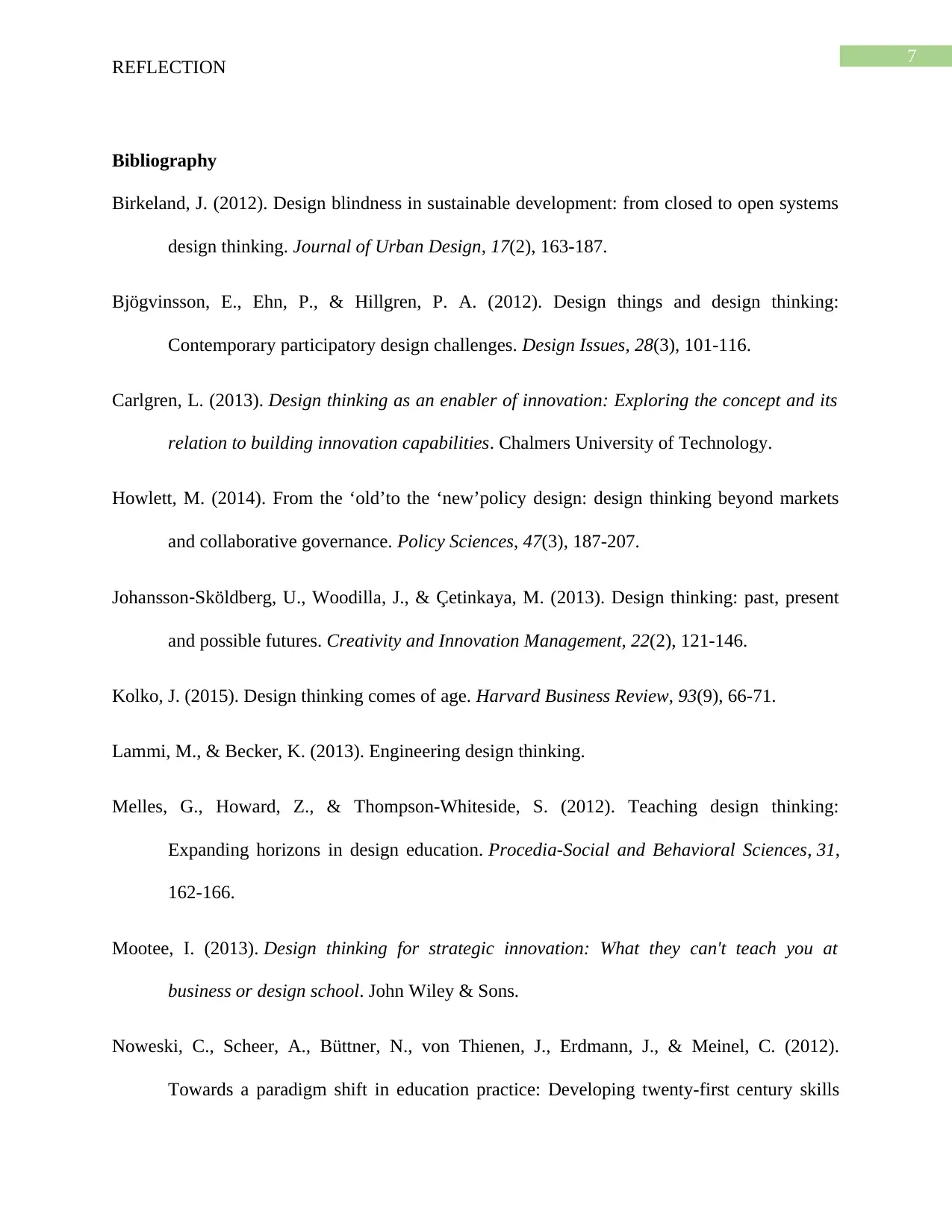
7
REFLECTION
Bibliography
Birkeland, J. (2012). Design blindness in sustainable development: from closed to open systems
design thinking. Journal of Urban Design, 17(2), 163-187.
Bjögvinsson, E., Ehn, P., & Hillgren, P. A. (2012). Design things and design thinking:
Contemporary participatory design challenges. Design Issues, 28(3), 101-116.
Carlgren, L. (2013). Design thinking as an enabler of innovation: Exploring the concept and its
relation to building innovation capabilities. Chalmers University of Technology.
Howlett, M. (2014). From the ‘old’to the ‘new’policy design: design thinking beyond markets
and collaborative governance. Policy Sciences, 47(3), 187-207.
Johansson‐Sköldberg, U., Woodilla, J., & Çetinkaya, M. (2013). Design thinking: past, present
and possible futures. Creativity and Innovation Management, 22(2), 121-146.
Kolko, J. (2015). Design thinking comes of age. Harvard Business Review, 93(9), 66-71.
Lammi, M., & Becker, K. (2013). Engineering design thinking.
Melles, G., Howard, Z., & Thompson-Whiteside, S. (2012). Teaching design thinking:
Expanding horizons in design education. Procedia-Social and Behavioral Sciences, 31,
162-166.
Mootee, I. (2013). Design thinking for strategic innovation: What they can't teach you at
business or design school. John Wiley & Sons.
Noweski, C., Scheer, A., Büttner, N., von Thienen, J., Erdmann, J., & Meinel, C. (2012).
Towards a paradigm shift in education practice: Developing twenty-first century skills
REFLECTION
Bibliography
Birkeland, J. (2012). Design blindness in sustainable development: from closed to open systems
design thinking. Journal of Urban Design, 17(2), 163-187.
Bjögvinsson, E., Ehn, P., & Hillgren, P. A. (2012). Design things and design thinking:
Contemporary participatory design challenges. Design Issues, 28(3), 101-116.
Carlgren, L. (2013). Design thinking as an enabler of innovation: Exploring the concept and its
relation to building innovation capabilities. Chalmers University of Technology.
Howlett, M. (2014). From the ‘old’to the ‘new’policy design: design thinking beyond markets
and collaborative governance. Policy Sciences, 47(3), 187-207.
Johansson‐Sköldberg, U., Woodilla, J., & Çetinkaya, M. (2013). Design thinking: past, present
and possible futures. Creativity and Innovation Management, 22(2), 121-146.
Kolko, J. (2015). Design thinking comes of age. Harvard Business Review, 93(9), 66-71.
Lammi, M., & Becker, K. (2013). Engineering design thinking.
Melles, G., Howard, Z., & Thompson-Whiteside, S. (2012). Teaching design thinking:
Expanding horizons in design education. Procedia-Social and Behavioral Sciences, 31,
162-166.
Mootee, I. (2013). Design thinking for strategic innovation: What they can't teach you at
business or design school. John Wiley & Sons.
Noweski, C., Scheer, A., Büttner, N., von Thienen, J., Erdmann, J., & Meinel, C. (2012).
Towards a paradigm shift in education practice: Developing twenty-first century skills
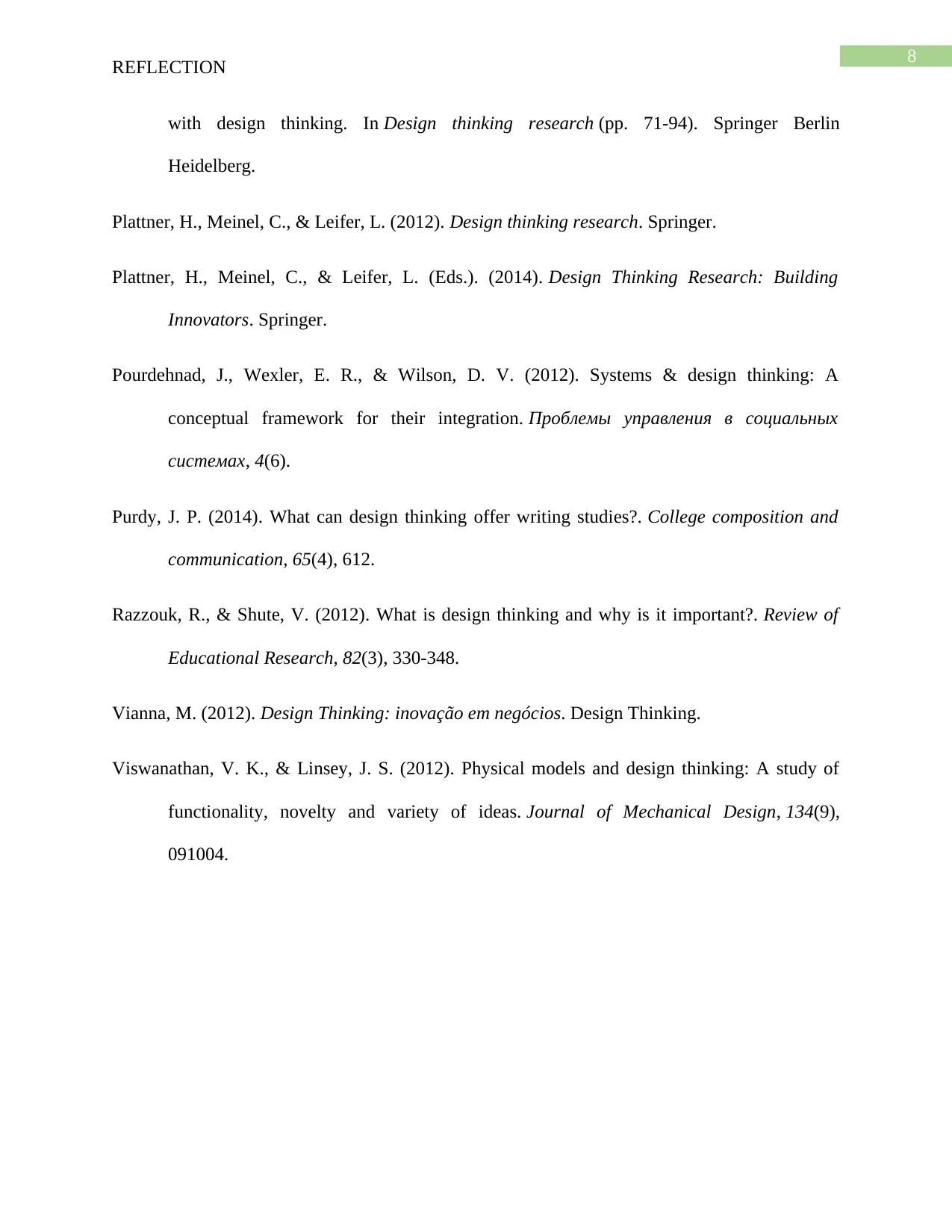
8
REFLECTION
with design thinking. In Design thinking research (pp. 71-94). Springer Berlin
Heidelberg.
Plattner, H., Meinel, C., & Leifer, L. (2012). Design thinking research. Springer.
Plattner, H., Meinel, C., & Leifer, L. (Eds.). (2014). Design Thinking Research: Building
Innovators. Springer.
Pourdehnad, J., Wexler, E. R., & Wilson, D. V. (2012). Systems & design thinking: A
conceptual framework for their integration. Проблемы управления в социальных
системах, 4(6).
Purdy, J. P. (2014). What can design thinking offer writing studies?. College composition and
communication, 65(4), 612.
Razzouk, R., & Shute, V. (2012). What is design thinking and why is it important?. Review of
Educational Research, 82(3), 330-348.
Vianna, M. (2012). Design Thinking: inovação em negócios. Design Thinking.
Viswanathan, V. K., & Linsey, J. S. (2012). Physical models and design thinking: A study of
functionality, novelty and variety of ideas. Journal of Mechanical Design, 134(9),
091004.
REFLECTION
with design thinking. In Design thinking research (pp. 71-94). Springer Berlin
Heidelberg.
Plattner, H., Meinel, C., & Leifer, L. (2012). Design thinking research. Springer.
Plattner, H., Meinel, C., & Leifer, L. (Eds.). (2014). Design Thinking Research: Building
Innovators. Springer.
Pourdehnad, J., Wexler, E. R., & Wilson, D. V. (2012). Systems & design thinking: A
conceptual framework for their integration. Проблемы управления в социальных
системах, 4(6).
Purdy, J. P. (2014). What can design thinking offer writing studies?. College composition and
communication, 65(4), 612.
Razzouk, R., & Shute, V. (2012). What is design thinking and why is it important?. Review of
Educational Research, 82(3), 330-348.
Vianna, M. (2012). Design Thinking: inovação em negócios. Design Thinking.
Viswanathan, V. K., & Linsey, J. S. (2012). Physical models and design thinking: A study of
functionality, novelty and variety of ideas. Journal of Mechanical Design, 134(9),
091004.
⊘ This is a preview!⊘
Do you want full access?
Subscribe today to unlock all pages.

Trusted by 1+ million students worldwide
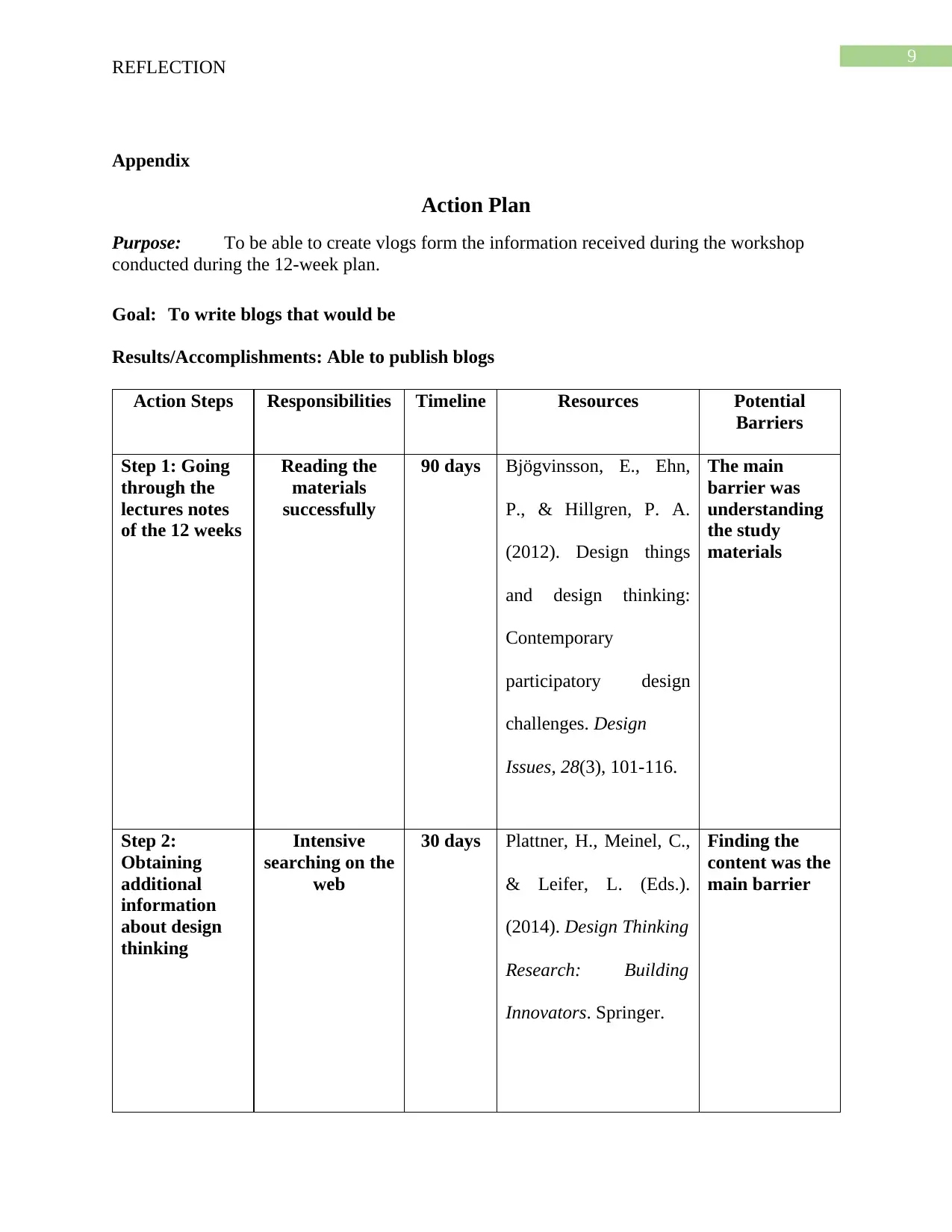
9
REFLECTION
Appendix
Action Plan
Purpose: To be able to create vlogs form the information received during the workshop
conducted during the 12-week plan.
Goal: To write blogs that would be
Results/Accomplishments: Able to publish blogs
Action Steps Responsibilities Timeline Resources Potential
Barriers
Step 1: Going
through the
lectures notes
of the 12 weeks
Reading the
materials
successfully
90 days Bjögvinsson, E., Ehn,
P., & Hillgren, P. A.
(2012). Design things
and design thinking:
Contemporary
participatory design
challenges. Design
Issues, 28(3), 101-116.
The main
barrier was
understanding
the study
materials
Step 2:
Obtaining
additional
information
about design
thinking
Intensive
searching on the
web
30 days Plattner, H., Meinel, C.,
& Leifer, L. (Eds.).
(2014). Design Thinking
Research: Building
Innovators. Springer.
Finding the
content was the
main barrier
REFLECTION
Appendix
Action Plan
Purpose: To be able to create vlogs form the information received during the workshop
conducted during the 12-week plan.
Goal: To write blogs that would be
Results/Accomplishments: Able to publish blogs
Action Steps Responsibilities Timeline Resources Potential
Barriers
Step 1: Going
through the
lectures notes
of the 12 weeks
Reading the
materials
successfully
90 days Bjögvinsson, E., Ehn,
P., & Hillgren, P. A.
(2012). Design things
and design thinking:
Contemporary
participatory design
challenges. Design
Issues, 28(3), 101-116.
The main
barrier was
understanding
the study
materials
Step 2:
Obtaining
additional
information
about design
thinking
Intensive
searching on the
web
30 days Plattner, H., Meinel, C.,
& Leifer, L. (Eds.).
(2014). Design Thinking
Research: Building
Innovators. Springer.
Finding the
content was the
main barrier
Paraphrase This Document
Need a fresh take? Get an instant paraphrase of this document with our AI Paraphraser
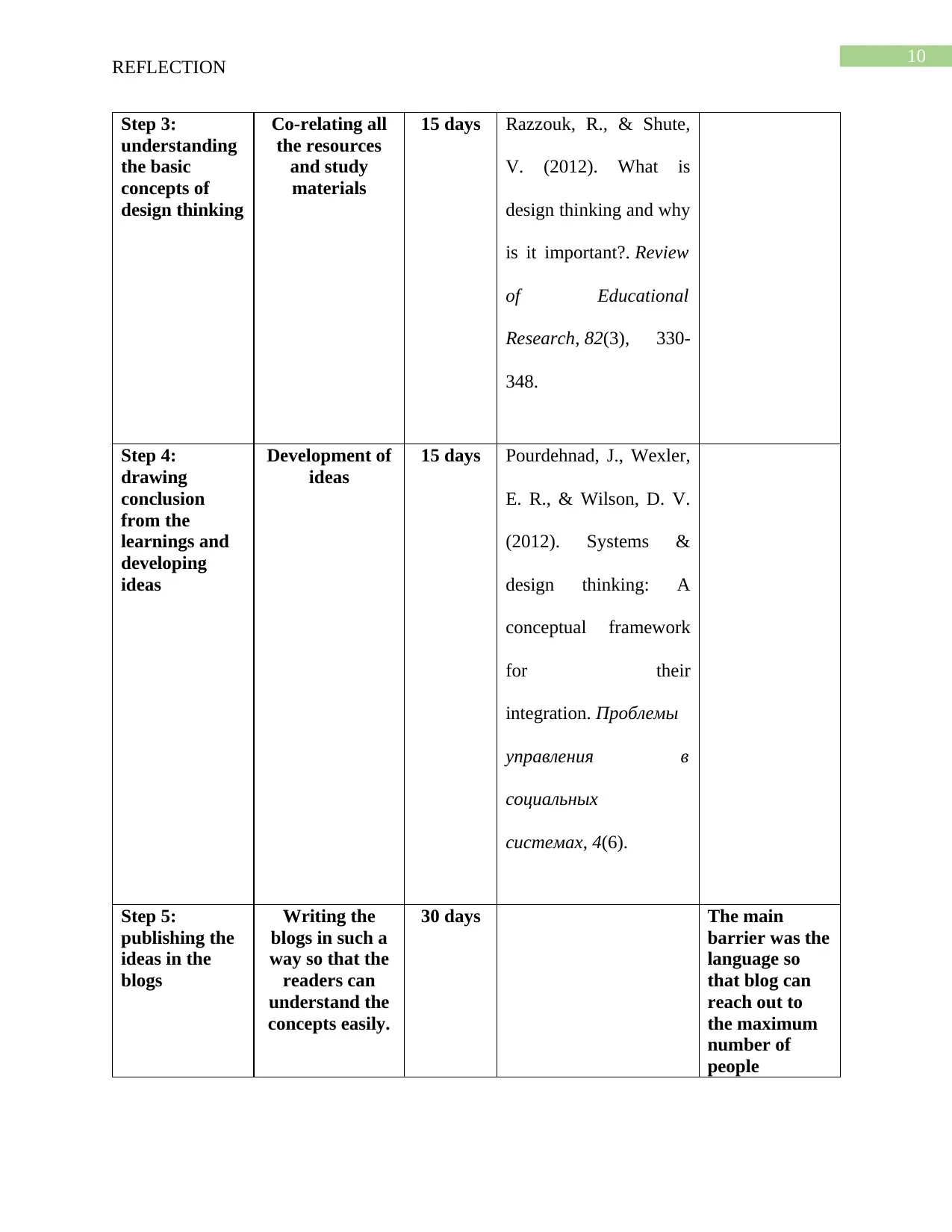
10
REFLECTION
Step 3:
understanding
the basic
concepts of
design thinking
Co-relating all
the resources
and study
materials
15 days Razzouk, R., & Shute,
V. (2012). What is
design thinking and why
is it important?. Review
of Educational
Research, 82(3), 330-
348.
Step 4:
drawing
conclusion
from the
learnings and
developing
ideas
Development of
ideas
15 days Pourdehnad, J., Wexler,
E. R., & Wilson, D. V.
(2012). Systems &
design thinking: A
conceptual framework
for their
integration. Проблемы
управления в
социальных
системах, 4(6).
Step 5:
publishing the
ideas in the
blogs
Writing the
blogs in such a
way so that the
readers can
understand the
concepts easily.
30 days The main
barrier was the
language so
that blog can
reach out to
the maximum
number of
people
REFLECTION
Step 3:
understanding
the basic
concepts of
design thinking
Co-relating all
the resources
and study
materials
15 days Razzouk, R., & Shute,
V. (2012). What is
design thinking and why
is it important?. Review
of Educational
Research, 82(3), 330-
348.
Step 4:
drawing
conclusion
from the
learnings and
developing
ideas
Development of
ideas
15 days Pourdehnad, J., Wexler,
E. R., & Wilson, D. V.
(2012). Systems &
design thinking: A
conceptual framework
for their
integration. Проблемы
управления в
социальных
системах, 4(6).
Step 5:
publishing the
ideas in the
blogs
Writing the
blogs in such a
way so that the
readers can
understand the
concepts easily.
30 days The main
barrier was the
language so
that blog can
reach out to
the maximum
number of
people
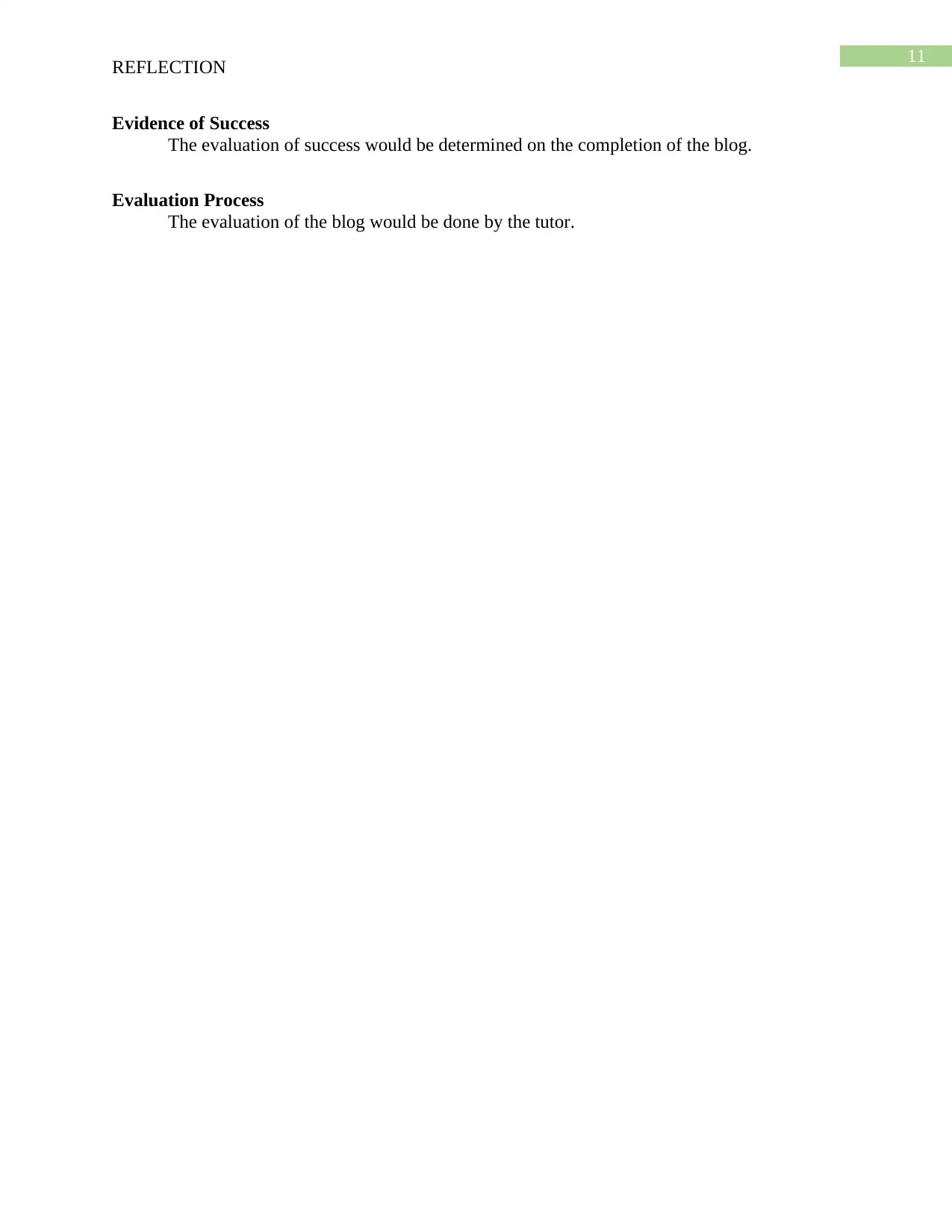
11
REFLECTION
Evidence of Success
The evaluation of success would be determined on the completion of the blog.
Evaluation Process
The evaluation of the blog would be done by the tutor.
REFLECTION
Evidence of Success
The evaluation of success would be determined on the completion of the blog.
Evaluation Process
The evaluation of the blog would be done by the tutor.
⊘ This is a preview!⊘
Do you want full access?
Subscribe today to unlock all pages.

Trusted by 1+ million students worldwide
1 out of 12
Related Documents
Your All-in-One AI-Powered Toolkit for Academic Success.
+13062052269
info@desklib.com
Available 24*7 on WhatsApp / Email
![[object Object]](/_next/static/media/star-bottom.7253800d.svg)
Unlock your academic potential
Copyright © 2020–2025 A2Z Services. All Rights Reserved. Developed and managed by ZUCOL.


